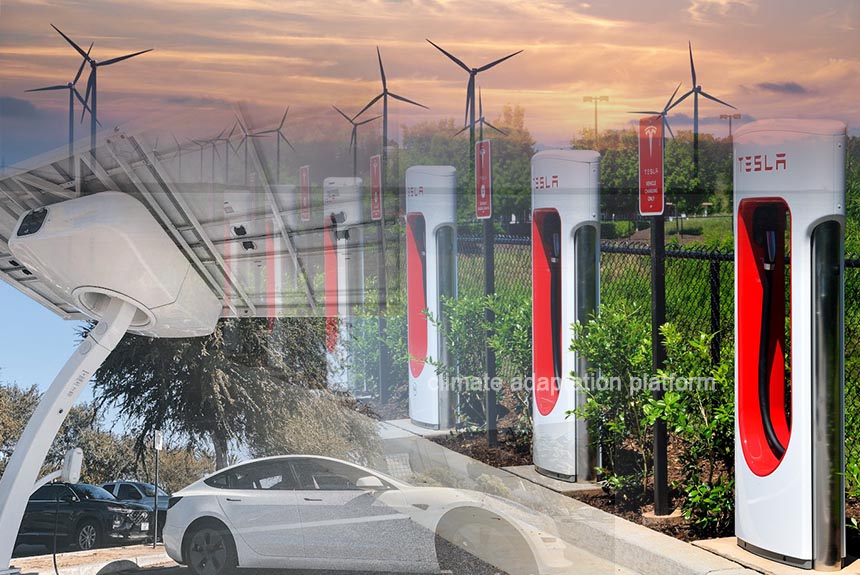Electric vehicles are considered an environmentally friendly and clean alternative to internal combustion cars. When charged by a renewable source, they reduce or remove tailpipe pollution and can reduce CO2 emissions from the transportation sector.
Recent US laws, including the 2021 Infrastructure Investment and Jobs Act (IIJA) and the 2022 Inflation Reduction Act (IRA), are focused on boosting the development and adoption of electric vehicles in the country.
The goal is to electrify the transportation sector, help the nation achieve its climate targets outlined in the Paris Agreement, and limit the temperature rise to below 2°C. The IIJA allocates over $7.5 billion to support the expansion of electric vehicle infrastructure, along with an extra $43 billion in flexible funds that could be utilized for battery production, grid enhancements, updating auto industry facilities, and providing training and employment opportunities for existing auto workers.
Roughly $47 billion in the IRA is eligible to support the widespread adoption of EVs. Funding from the IIJA and IRA is distributed through various programs overseen by federal agencies, including DOT, the Department of Energy (DOE), and the Environmental Protection Agency (EPA).
The 2024 Study, “The Impact of state policies on electric vehicle adoption -A panel data analysis”, published in the Renewable and Sustainable Energy Reviews, underscores the crucial role of state policies in driving EV adoption in the United States. These policies, which include measures to mitigate the environmental impacts of energy production, financial incentives for EV buyers, and the establishment of public EV charging stations, play a significant part in the overall national strategy.
The study reveals the growing trend in EV sales in the U.S. from 2012 to 2020. In 2017, EV sales accounted for 1.2% of all vehicles sold, which climbed to 1.8% in 2020 and 8% in 2022. The trend in EV sales shows a growing acceptance of electric cars in the market. The Biden administration further set an ambitious goal of achieving an EV target sale of 50% by 2030.
In February 2023, to achieve the Biden-Harris administration’s goals towards a zero-emissions transportation sector by 2050, they invested $7.5 billion to build a national network of 500,000 EV chargers along US highways.
Aside from Federal-level policies, states also implemented numerous policies to promote EV adoption directly and indirectly, including various incentives such as state income tax credits and rebates for vehicle purchases, sales tax exemption, home charging stations incentives and direct investment to install public charging infrastructure. While EVs are not necessarily cheap, and their price could also be a barrier to their adoption, the driving range is also considered another challenge and increasing the number of charging stations could be a key.
While production in the EV industry has significantly increased in the US in the last decade, moving towards a large-scale energy transition to achieve the maximum benefit from EVs will require support from the government, particularly in policies relating to generating clean and renewable energy and increasing its share in the electricity grids.
Policies like the electric sector carbon tax and the renewable portfolio standards (RPS), which mandate that a certain percentage of a utility’s electricity be from low GHG energy sources, have stimulated renewable energy and low GHG energy generation in the US, nearly doubling in the last 20 years. These policies could also lead to the widespread adoption of EVs.
The study’s findings show that “a 1 % increase in a state’s low GHG energy share increases EV adoption rate by 1.7 %, and the reduction of per capita CO2 emissions from electricity generation by one metric ton increases EV adoption rate by 10.9 %. Financial incentives for EV purchase show that a $1000 increase in a state income tax credit increases the EV adoption rate by 10.1 %, while rebates did not have a statistically significant impact.”
Overall, findings show that EV adoption positively correlates to changes in state environmental policies—or those that increase the share of renewable or clean energy in the electric grid and reduce CO2 emissions from electricity generation—rather than financial incentives or charging infrastructure policy changes.
Therefore, this research “demonstrates the need to coordinate and nationalize policies that enhance low GHG energy sources to improve EV adoption across all states uniformly.”
Source:
Mekky, M. & Collins, A. (2024, March). The Impact of state policies on electric vehicle adoption – A panel data analysis. Renewable and Sustainable Energy Reviews. Retrieved from https://www.sciencedirect.com/science/article/abs/pii/S1364032123008729
Biden-Harris Administration Announces $15.5 Billion to Support a Strong and Just Transition to Electric Vehicles, Retooling Existing Plants, and Rehiring Existing Workers. (2023, August 31). Energy.gov. Retrieved from https://www.energy.gov/articles/biden-harris-administration-announces-155-billion-support-strong-and-just-transition
Burget, S. (2022, September 2). EV eligible funding in IIJA and IRA represents nearly 30 times the total EV funding awarded by U.S. government to date. EV Hub. Retrieved from https://www.atlasevhub.com/data_story/3-billion-in-federal-funding-for-evs-to-date/
Christianson, M. (2023, October 30). Tracking Electric Vehicle Investments in the Infrastructure Investment and Jobs Act and Inflation Reduction Act. EESI. Retrieved from https://www.eesi.org/articles/view/tracking-electric-vehicle-investments-in-the-infrastructure-investment-and-jobs-act-and-inflation-reduction-act



Leave a Reply